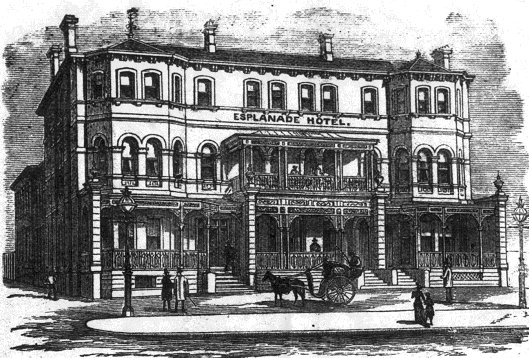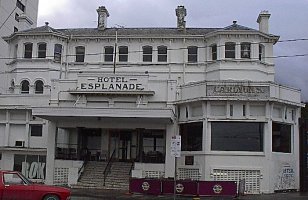|
|
|
Home | Introduction | Contents| Feedback | Map | Sources | Glossary |
|
14
Esplanade Hotel 11 The Esplanade, St Kilda
Just in time for the opening of the rail
connection to St Kilda in 1857, the New Bath Hotel opened on this site in that
year. Its orientation facing the beach and its name referring also to that
English Eighteenth Century resort town par excellence both evoked
pleasure.
The New (bathing)
That November the New Bath Hotel hosted an
exhibition for the St Kilda Horticultural Society, including ’choice specimens
of geraniums, fuchsias and pansies’. The 40th Regiment played music, perhaps
the
Esplanade Hotel, 1881
In 1861, the licence was transferred to
Charles Wedel & Moss and the New Bath became the
Criterion. In 1864,
In 1874, the hotel site was sold to James
Orkney, MLA for
The architects, Alfred Louis Smith
(c1830-1907) and Arthur Ebden Johnson (c1823-95) were Londoners who each worked
for important English designers: Smith for designing builder, Thomas
Cubitt and Johnson for the fine architect Philip
Hardwick. Johnson was talented and won the Soane
medal and a Royal Institute of British Architects prize. He advanced in
The first publican and lessee of The Esplanade
was James Grant Hay. Mark Twain visited
In 1892, the Esplanade’s most famous resident,
Alfred Felton (1882-1904) an industrial chemist, arrived to live there until he
died. He arrived in
Felton lived in a downstairs sitting room only 7.5 x 4.5m, using an upstairs bedroom. The sitting room was packed with pictures hung from every inch of wall and stacked against walls, with bookshelves overflowing, piles of catalogues, unopened copies of The Spectator and The Times and an indiscriminate collection of decorative arts. He was a keen collector of recorded music and owned one of the first cylinder gramophones his visitors had seen.
On his death, Felton gave £383.000 of his
£500,000 estate to the National Gallery of Victoria. Invested wisely, the Felton
Bequest money still purchases works for the gallery, a century later. Within
fifty years, it had transformed the
By 1914 both owner James Orkney and his widow Margaret had died and the Esplanade was sold to Edward and Martin Hoban. Peter McQuade was the lessee. Significantly by 1920, the lessee was Thomas Carlyon, of Carlyon’s Hotel, corner of Bourke and Spencer Streets. Carlyon had architects Gibbs and Finlay make renovations and additions, including a ballroom. Sarah Bernhardt, the great actress is said to have stayed at the Esplanade with an entourage of 12 assorted animals. Carlyon’s Esplanade became a premier jazz and dance venue. It was enormously popular, with music night after night. In 1924 his Eastern Tent Ballroom initiated popular nights when evening dress was optional and party nights which were formal. Overseas musicians were imported and locals, particularly in jazz, were encouraged and defended.
T.S Carlyon died
in 1925. In 1927 T.S. Carlyon Junior established the
famous Green Mill Dancehall on the site of Wirth’s Circus (now the Victorian
Arts Centre site). With his brother Norman he also had interests in the
Ambassador Hotel, the Hotel Australia and a
At the side of the hotel was a rockery where big bands played in the ‘30s and ‘40s. Entertainment in the ‘50s and ‘60s was mainly Saturday nights with television performers such as Harold Blair, Ron Lees and Barry Crocker.
In 1937, alterations by hotel architects
Sydney Smith, Ogg & Serpell
in the north-west corner created a new public bar. The Esplanade of the ‘40s
and ‘50s like the
Within the year, the Esplanade was sold to
Leon Wolawski who held it for twelve years. During
the 1960s, the ‘Snakepit’ basement bar was a
rendezvous for prostitutes on their work-breaks. By 1973, the Esplanade was
proposed as the venue for
In 1987 Eildon Pty Ltd again proposed an 18 storey building with the old hotel refurbished and 85 serviced apartments overhead.
Esplanade Hotel, 2004
Over the past 25 years, ‘the Espy’ has been
crucial in promoting cutting-edge Australian popular music. From 1994-98 there
were over 300 live recording sessions there, with about 25 different acts
performing live each week. It operated three venues in simultaneous
performance, for both paying and non-paying audiences, as well as its support
for the other arts. No other hotel in
By 1988-89 there was community concern that
development proposals threatened ‘the Espy’ and activism by Save St Kilda and
Turn the Tide began. In 1990 the National Trust responded by classifying the
hotel. In 1992 Save St Kilda wrote a Community Charter fearing that another
ownership transfer from Evinden
Pty.Ltd to Santope
Pty.Ltd may end the live music. The transfer was averted. In 1994 a
fire risk caused final eviction of all remaining permanent guests for the first
time in its 112 years. 65 poker machines were proposed. From 1995,
In 1997 it was bought by the Becton
Corporation’s Becton Esplanade Pty Ltd as one of
Earlier The
Age headlined: ‘... Godzilla that will dwarf one of the city’s favourite
watering holes and music venues’. Inexplicably, Heritage
For over thirty years, The Espy has resisted proposals for high rise apartments or casinos which local people and professionals are adamant would be an over-development of the site.
In May, Becton agreed to sell the hotel
section of the site. The Council introduced a Planning Scheme Amendment C25 to
control the height and bulk of development around the old hotel to an absolute
maximum height of 8-10 stories, stepping down to 3-5 stories. The Esplanade
Alliance felt satisfied that they had opposed Becton for five years, and won.
Indeed, in August, the Esplanade was sold, via a 200-year lease to nominee
companies of Savin and Disordet Pty Ltd. Vince
Sofo and Paul Adams of the Chevron nightclub and
other cafes, restaurants and clubs. On
When John Farnham announced his The Last Time
tour, he joked that he always dreamt of playing The Espy. Farnham’s manager,
Glenn Wheatley sent the hotel a demo tape which was accepted by The Espy’s
booking manager and so Whispering Jack finally played The Espy on
Notes John Poynter’s Mr Felton’s Bequest was published after this Chapter was written, too late for its meticulous content to be used here. References
Bisset,
Andrew. Black Roots White Flowers: A History of Jazz in
Carson, Andrea. ‘Street Fights: In the thick of it, they celebrate the saving of a community icon ... the Espy’. The Age. 13 May 2001. Cooper, J.B.. The History of St Kilda: From its First Settlement to a City and After. Vols. 1 & 2. Printers. Melbourne 1931. p226.
de Kraster, Leela
and van Nooten, Brocke.
‘Legends aid Espy bid to
rock on’ Herald Sun
Giggney, H.J. & Smith, Ann G, A Biographical Register 1788-1939, Australian Dictionary of Biography, Canberra 1987, pp 265 & 371.
Keenan,
Aileen. ‘Espy’ hotel sold to business pair’. The Age.
Lindsay,
Daryl. The Felton Bequest.
An Historical Record. 1904-1959.
Munroe, Ian.
‘Trust Power v.
National Trust
of
Njoo,
Alex. ‘Once more unto the breach’.
Letter. The Age.
Poynter, John.Mr Felton’s Bequest Miegunyah Press. Carlton 2003. Revisiting Major Planning Proposals. 1980-2000. pp4-39.
The Argus.
Timothy Hubbard
Pty.Ltd.
The Esplanade Hotel. A
Report to the Heritage Council of
|
|
St Kilda Historical Society Inc. © 2005 |




